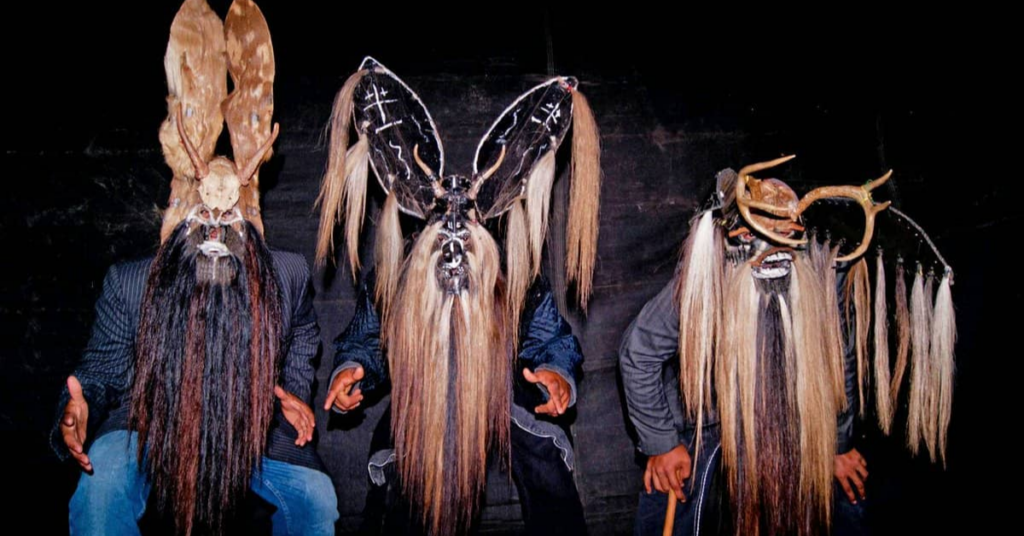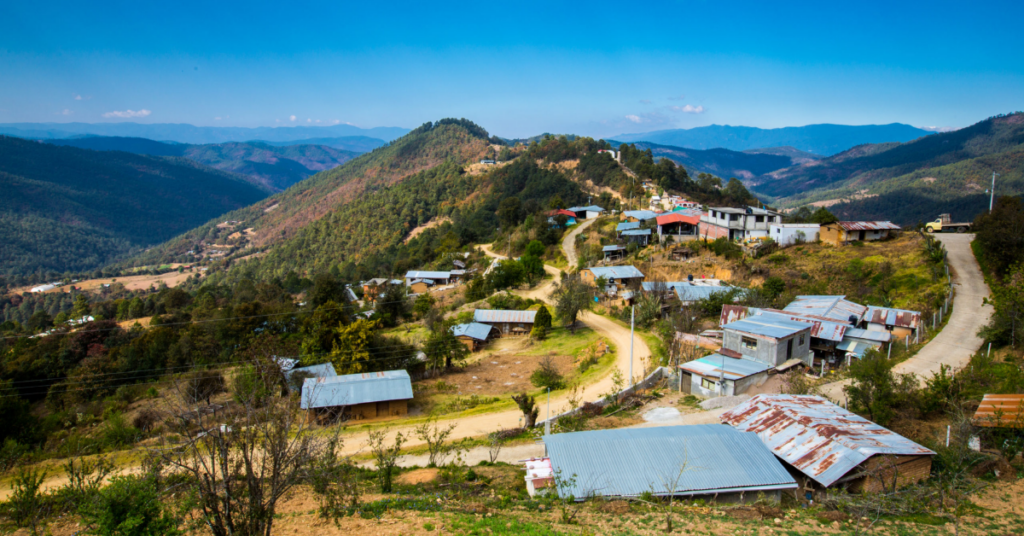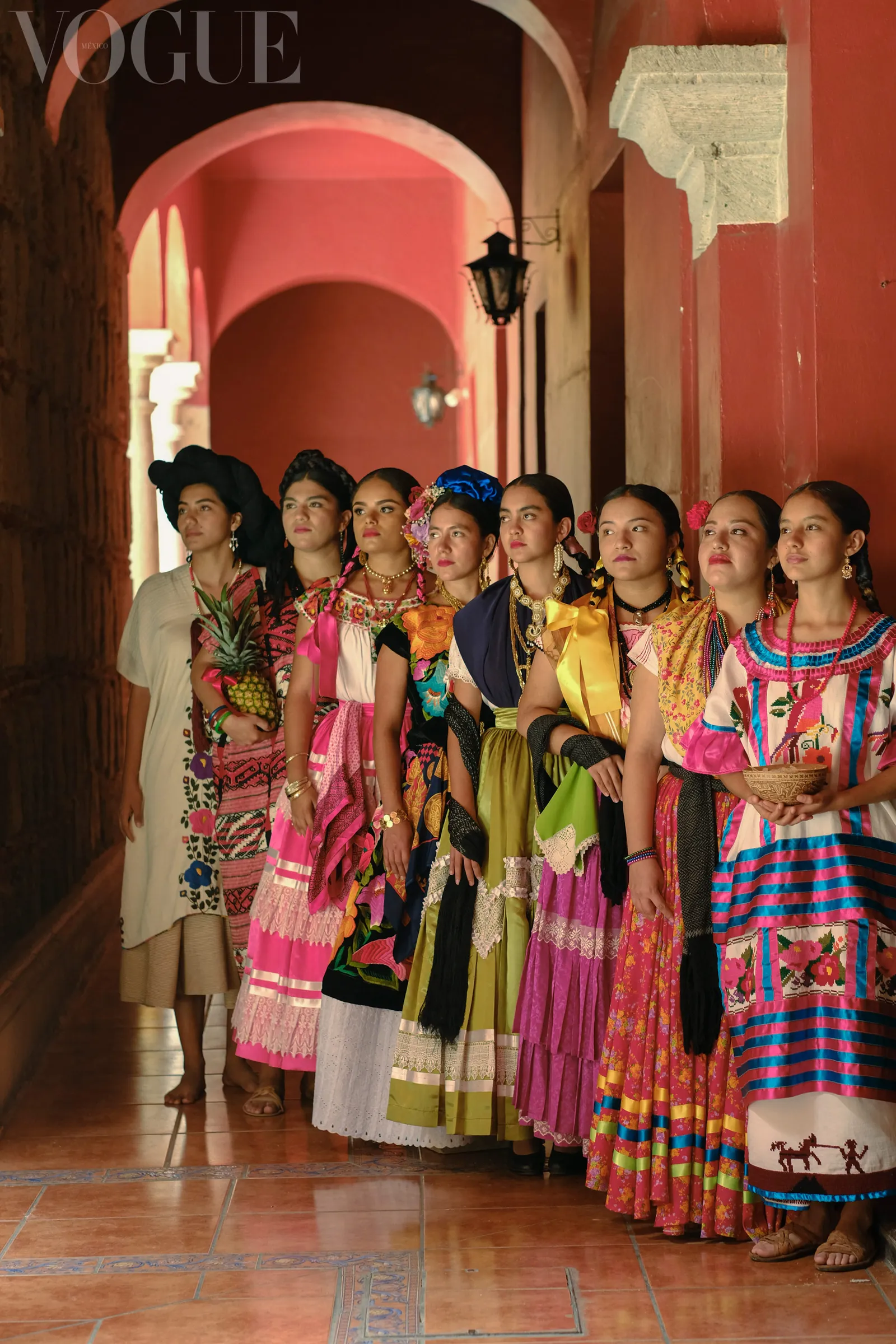We invite you to delve into the rich culture and traditions that make Oaxaca, Mexico, a truly unique destination. From ancestral customs to contemporary practices, the eight regions of Oaxaca are a mosaic of cultural diversity.
Join us on a journey through these regions, as we introduce you to the unique customs and traditions that define each one. Get ready to explore topics such as:
Regional cuisine, festive events, art, local crafts, and much more. Prepare to uncover the beauty of Oaxaca’s cultural diversity, and along the way, perhaps discover a bit more about yourself.
Costa Region: Traditions and Customs
Traditional Dances

The vibrant Costa Region of Oaxaca is as rich in landscapes as it is in cultural traditions. Among these, traditional dances stand out, which are more than mere rhythmic movements; they are narratives where each step tells a story. One of the most emblematic dances is the Turtle Dance, performed mainly in the Afro-Mexican community of Cuajinicuilapa, where dancers skillfully imitate the movement of these marine animals. Likewise, the dance of the Chileans combines African, indigenous, and Spanish influences in a fluid cultural exchange expressed through dance.
Festivals and Celebrations

Festivals and celebrations in the Oaxacan Coast are a display of joy and community. Among them, the Feast of the Virgin of Juquila stands out for its spiritual fervor, attracting thousands of pilgrims to the town of Santa Catarina Juquila year after year. Additionally, carnivals, especially the one in Pinotepa Nacional, showcase the festive spirit of the region, expressed through colorful parades, music, and the tireless camaraderie of its inhabitants.
Unique Gastronomy
The cuisine of the Oaxacan Coast is unparalleled, with flavors and preparations that captivate the senses. Dishes like grilled fish, seafood soup, and the emblematic shrimp a la diabla reflect the rich biodiversity of the Pacific. The use of local ingredients like coastal chili provides an authentic and distinctive touch to its dishes. Equally important is tepache, a fermented pineapple beverage that accompanies diners during festivities and everyday gatherings.
Cañada Region: Its Traditions and Culture
Local Handicrafts

In the heart of the Cañada Region of Oaxaca, the artistic and craft expressions of its inhabitants are woven. Textiles, such as those made in the community of San Felipe Usila, are recognized for their ancestral techniques, vibrant colors, and designs that narrate regional myths and legends. Black pottery, originating from San Bartolo Coyotepec and known worldwide for its unique finish and shine without using paints, is another magnificent example of local ingenuity and talent.
Religious Festivals
The Cañada Region fervently celebrates its religious festivals. The Feast of the Virgin of Candelaria in Teotitlán de Flores Magón is one of the most prominent, involving the entire community in a series of rituals and processions. During Holy Week, symbolic representations of the Passion of Christ take place, demonstrating the deep synchronization of indigenous beliefs with Spanish Catholicism established during colonization.
Typical Cuisine

Typical food is essential to the cultural identity of the Cañada Region. Mole is a dish that cannot be missed, with each family boasting a unique recipe passed down through generations. Stone soup, originating from San Felipe Usila, is a sensory experience, prepared by heating red stones and cooking the ingredients inside a gourd, a culinary spectacle. Mole tamales with turkey, wrapped in banana leaves, are another delight that any visitor or local eagerly anticipates enjoying during festivities and celebrations.
Discovering the Isthmus Region of Tehuantepec
Traditional Attire
The Isthmus Region of Tehuantepec is particularly known for its traditional attire, filled with color, art, and symbolism. The Tehuana costume, proudly worn by Zapotec women, is characterized by embroidered huipiles and wide skirts that highlight their matriarchy. These costumes are not just clothing but expressions of identity and social status. The elegance and complexity of these outfits have led them to be internationally recognized, inspiring artists like Frida Kahlo.
Key Celebrations
The main celebrations in the Isthmus are vibrant and full of traditions rich in symbolism. The Vela Istmeña is one of the most outstanding, a grand celebration that lasts all night where families and friends gather to enjoy music, dance, and, of course, local cuisine. Another important festivity is Holy Week, where processions and representations of the life and passion of Christ take on a particular nuance in this region with an atmosphere full of devotion and respect.
Outstanding Gastronomy
The outstanding gastronomy of the Isthmus of Tehuantepec is as varied as it is exquisite. Iguana tamales, though not for every taste, are an unparalleled local delicacy for adventurous palates. Isthmus garnachas, small fried tortillas topped with meat and sauce, are a popular craving at festivities. And one cannot fail to mention seafood prepared in the Isthmus style, reflecting the rich harvest provided by both the sea and the lagoons of the region.
Papaloapan Region: More than a Place, an Experience
Music and Dances

The Papaloapan Region of Oaxaca vibrates to the rhythm of its traditional music and dances, which are an essential part of its cultural heritage. Son Jarocho, with its emblematic harp and the strumming of the strings of the jarana and the son guitar, is the musical heart of the region. As for dance, the fandango is the quintessential social dance, where the platform becomes the main stage for energetic and joyful footwork. These practices are not just entertainment but also a means of communication and community expression.
Traditional Festivals
Traditional festivals in the Papaloapan region are a crucible of devotion and celebration. The Festival of the Sotaventina, an annual gathering that celebrates local Son Jarocho traditions, is a window into the living culture of this area. Additionally, the feast of El Día de los Santos Reyes in Tuxtepec is especially known for its grand parade of floats and masses that blend Catholic rites with indigenous customs.
Native Cuisine
The native cuisine of Papaloapan is intimately linked to the natural resources of the lush river that gives it its name. Delights such as green chicken, a stew of chicken with regional herbs and spices, and “piedrazos,” buns of dough filled with seafood, are just a sample of its rich culinary diversity. Equally remarkable is pineapple tepache, a homemade fermented beverage that refreshes and accompanies meals on hot and festive days.
Sierra Norte and its Traditions
Nature and Culture

The Sierra Norte of Oaxaca is a region where nature and culture coexist in harmony. With biodiversity that astounds, its cloud forests are home to communities that have preserved their traditions in balance with the environment. Activities such as ecotourism and birdwatching in places like Pueblos Mancomunados are a way to experience the culture while respecting the natural richness surrounding these populations, many of which still speak indigenous languages such as Zapotec and Mixe.
Ancestral Celebrations
Ancestral celebrations in the Sierra Norte reflect a worldview that endures through time. One of the most important is the Day of the Dead celebration, where inhabitants honor their loved ones with ornate altars and candles that illuminate the paths to guide the souls. The Guelaguetza is also celebrated in these mountainous areas, highlighting the generosity and cultural richness of indigenous communities that share their dances, music, and local products.
Local Gastronomy
The local gastronomy of the Sierra Norte has a distinctive flavor marked by the region’s ingredients. Stone soup, originating from this area, is an example of ingenuity in the kitchen: hot stones cook the ingredients inside a gourd, resulting in a smoky and unique flavor. Tlayudas with asiento and quesillos are other delights that satisfy the appetites of inhabitants and visitors, all seasoned with wild herbs that grow in local forests.
Sierra Sur Region: Culture and Tradition
Art and Handicrafts
The Sierra Sur de Oaxaca is a hidden treasure of art and craftsmanship. Here, leatherwork stands out, and the creation of products such as saddles, boots, and belts reflects the skill and dedication of local artisans. Additionally, pottery in the region maintains inherited techniques that produce unique clay pieces, each narrating its own story with its shapes and decorations.
Festivals and Celebrations

Festivals and celebrations in the Sierra Sur are a vivid expression of communal spirit and rich cultural heritage. In the community of San Pedro Mixtepec, for example, the annual celebration of the Day of the Martyrs takes place, commemorating the struggle and resistance of local figures. Local music and folk dances mingle with religious and civil activities, creating memorable events that attract visitors from across the state.
Traditional Cuisine
The traditional cuisine of the Sierra Sur surprises with intense flavors and inherited preparations. A representative dish is “seguesado,” a stew of beef or goat seasoned with a rich blend of local herbs and spices. The preparation of mezcal, a distilled spirit with designation of origin deeply rooted in Oaxacan culture, is also an intrinsic part of daily life and celebrations in this region, with each producer offering unique flavors and characteristics.
Mixteca Region: The Heart of Oaxaca
Traditions and Customs
Known as the heart of Oaxaca due to its rich history and fundamental role in the state’s culture, the Mixteca Region is a crucible of ancient traditions and customs. Here, the art of weaving is preserved, creating wonderful handcrafted pieces on waist looms. Agricultural rituals, such as ceremonies to ask the gods revered in these lands for rain, are evidence of the deep connection between the community and its natural environment.
Popular Festivals
Festivals and celebrations are experienced with great passion in the Mixteca. One of the most anticipated events is the celebration of La Samaritana, a religious festival during which fruit water is distributed to the community in remembrance of the biblical encounter between the Samaritan woman and Jesus. The Feast of the Kings in Tlaxiaco is also notable, known for its indigenous dances, vibrant music, and the joy that fills the attendees.
Flavor and Gastronomy
The flavor and gastronomy of the Mixteca Region entice palates with dishes like Mixteco pot stew, a stew brimming with indigenous and Spanish flavors in exquisite balance. Tlayudas, known as the Oaxacan pizzas, cannot be missed, combining basic but delicious ingredients like beans and local cheese. Additionally, the Mixteca is home to barley beer, a craft beverage that reflects the ingenuity and unique flavor of the region.
Valles Centrales: The Soul of Oaxaca
History and Culture

The Valles Centrales are the vibrant soul of Oaxaca, where the paths of pre-Hispanic, colonial, and modern history and culture intersect. In places like Monte Albán, an important archaeological site, one can witness the legacy of the ancient Zapotecs. In the city of Oaxaca, colonial architecture is magnificently preserved and merges with the living traditions of indigenous communities, creating a space where the past dialogues with the present.
Festivals and Events
A rich variety of festivals and events take place throughout the year in the Valles Centrales. The Guelaguetza, probably Oaxaca’s most famous festival, showcases the state’s cultural diversity with dances and music from the eight regions. Another significant event is the Night of the Radishes, celebrated every December 23rd in the Zócalo of Oaxaca, where intricate sculptures made of radishes grown specifically for this tradition, which dates back over 100 years, are exhibited.
Typical Cuisine

The typical cuisine of the Valles Centrales is famous for its diversity and innovation. Dishes like Oaxacan mole in its different varieties are a feast of flavor and color. Quesillo and tlayuda are examples of street food that delights those strolling through the streets of Oaxaca City. Mezcal cannot be overlooked, the iconic distilled spirit of the region, which has become a global symbol of Oaxacan culture.
Therefore, Oaxaca, with its eight unique regions, offers a diverse range of traditions and customs that reflect its rich history and vibrant culture. From the intricate weavings of the Mixteca region to the colorful festivals of the Costa region, and the impressive architecture of the Valles Centrales region, each region has something special to offer. This diversity is what makes Oaxaca a fascinating place to explore and a living treasure of Mexican culture.
Frequently Asked Questions
What are some of the traditional dances of the Costa Region of Oaxaca?
Some of the traditional dances of the Costa Region include the Chilean and the Son Pinotepa Nacional, which are expressions of joy and celebration characteristic of the region.
What type of crafts can be found in the Cañada Region?
In the Cañada Region, you can find a variety of pottery, jars, and ceramics, as well as beautiful creations of handmade textiles.
What is the typical attire of the Isthmus Region of Tehuantepec?
In the Isthmus Region of Tehuantepec, women often wear costumes called ‘tehuana,’ which consist of a blouse and skirt embroidered by hand with beautiful designs, while men typically dress in white with a hat.
What is the native food of the Papaloapan Region?
The Papaloapan Region is distinguished by its native food based on red meats, fish, and seafood, as well as the use of local chilies and spices to give its dishes a unique flavor.
What ancestral celebrations take place in the Sierra Norte de Oaxaca?
In the Sierra Norte de Oaxaca, ancestral rituals related to nature and the elements are still celebrated, such as festivals in honor of rain, harvest, and Mother Earth.
What art and craftsmanship stand out in the Sierra Sur Region?
The Sierra Sur Region of Oaxaca is famous for its leather and stone craftsmanship, especially the carving of fantastic animal figures known as alebrijes.
What is the flavor and gastronomy of the Mixteca Region of Oaxaca?
The Mixteca Region stands out for its gastronomy based on corn, such as handmade tortillas, tamales, and mole, among other delights.
What festivals and events are popular in the Valles Centrales of Oaxaca?
The Valles Centrales of Oaxaca are famous for their cultural festivals and events, among which the Guelaguetza stands out, a celebration featuring traditional Oaxacan dances and music.
What can be learned from the history and culture of the Valles Centrales?
The Valles Centrales are the cultural and historical heart of Oaxaca, with archaeological sites like Monte Albán, and they are the epicenter of the state’s cultural and artistic life.
What is the typical gastronomy of the Valles Centrales of Oaxaca?
The gastronomy of the Valles Centrales is diverse and rich, featuring famous Oaxacan mole, fresh cheese, tasajo (thinly sliced beef), chapulines (grasshoppers), and artisanal mezcals.






















